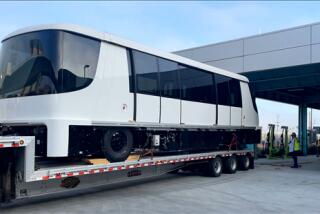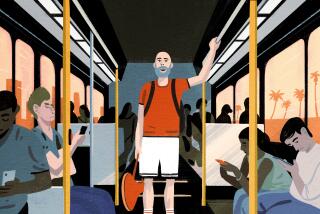Cars of Desire : Man Restores Trolley Fleet
He’ll be back on track soon, Richard J. Fellows promises. Just as fast as he can finish the remodeling project that he’s doing around the house for his wife.
Fellows is itching to get back in gear with his own pet construction project. He’s building a personal trolley system.
He has been at it for 30 years--spending every spare moment bolting down passenger seats, attaching hydraulic brakes and installing bells for conductors to clang. So far, he has completed one coach, almost finished another and started work on two others.
When he is finished, Fellows will own Los Angeles’ last rolling remnants of the historic Red Car network, the transportation system that for half a century helped guide the development of Southern California.
Fellows has rescued abandoned hulks of Pacific Electric coaches from scrap piles and back yards and set out to painstakingly restore them. He is replacing their electric motors with gasoline engines and exchanging their rusty iron wheels for modern rubber tires.
He plans to send his tiny streetcar fleet onto the streets to demonstrate how Los Angeles moved in the days before there was an automobile in every garage and a traffic jam in every rearview mirror.
At its peak, Pacific Electric’s red-painted trolleys were making 6,000 trips a day. Its rails stretched nearly 1,200 miles to link Canoga Park with Redlands, San Fernando with Balboa, and hundreds of communities in-between with downtown Los Angeles.
By the time the last of the “Big Red Cars” was removed from service in the early 1960s, the trolley lines had become the blueprint for the modern freeway system that helped kill them.
“The Pacific Electric was a wonderful system,” said Fellows, 55. “My mom used to say the best birthday present for me was to let me get on one of these cars in Cerritos and ride down to the Long Beach Pike” amusement park pier.
So Fellows was jolted one day in 1961, when he glanced out the office window at his family’s shipyard on Terminal Island. On the dock next door were dozens of the beloved Red Cars. They were stacked in piles, waiting to be shipped to Japan as scrap.
The neighboring dock owner let him buy one of the streetcars for its scrap value: $350. He also invited Fellows to help himself to lamps, seats and other accessories from other junked coaches that were of no value to the overseas metal recycler.
Fellows quickly learned that an even older wooden Red Car was stored behind a Compton heating company. He immediately offered to buy it.
For $50, he became the owner of No. 1058, one of the most famous Red Car body styles ever used. It was a classic wood-sided coach built in 1913 that had carried passengers until the late 1930s. After that, it had been used by heating company workers as a storage shed.
“It was a shell when I found it,” Fellows said. “There was not a piece of glass or a piece of hardware on it. One end was bashed in. The other end was burned out.”
Using construction techniques he had learned at the shipyard, Fellows renovated the wooden car during the next three years.
Shipyard employees also joined in the repair project, helping replace rotted Honduran mahogany inside the coach with Philippine mahogany. Fellows had glass cut to fit the car’s 144 windows. The salvaged seats were installed to give it an authentic look.
To make it roadworthy, a 1964 Chrysler automobile engine was carefully hidden beneath the 55 1/2-foot-long trolley’s floorboards. The coach’s original emergency “dead man’s” brake pedal was converted into a throttle. Its speed control lever was turned into a steering handle.
When it was finished, Fellows began driving it to special events such as parades, civic gatherings, community picnics to which he was invited.
“The whole idea was to take it to the people,” he said. “I thought they should be able to see what these cars were like. I wanted them to understand what these cars had done for this community.”
Since then, Fellows has purchased two more junked Red Cars and has renovated the trolley he rescued from the dock. It is a wide-bodied metal coach known to Pacific Electric motormen as a “Hollywood Car.” It was built in St. Louis in 1924 and used daily until 1958.
His other two trolleys are both wood-sided cars. One was built in 1901 and used for 32 years on the Los Angeles-Long Beach line. The other was constructed in 1907 and used on the “Venice Short Line” through 1950.
Fellows intends to get all of them on the road, although he admits that it is becoming increasingly difficult to get permits from cities to drive machinery this size on public streets. Insurance for his one drivable trolley costs $4,000 a year.
“People can’t believe it when they see it coming down the street,” said Bruce Malkenhorst, city administrator of Vernon, where Fellows keeps his trolley fleet. “I saw an RTD bus almost run off the road when its driver saw the Red Car.”
Fellows said he uses a pole to measure underpasses and low-hanging power lines before he takes out his 15-foot-high coach. He uses a chase car and a helper stationed at the rear of the coach to warn motorists of the Red Car’s wide turning radius.
Even traffic lights require advance planning: It takes 200 feet to stop when the 30-ton Red Car is traveling 30 m.p.h., he said.
“The Red Cars met the needs of their time. But in today’s environment of liability and lawsuits, they would not be feasible,” said Anthony Greno, spokesman for the Southern California Rapid Transit District--which last year got into the trolley business by opening the computer-assisted Metro Rail Blue Line between Los Angeles and Long Beach.
Fellows’ Red Car played a role when the Blue Line began service. The county Transportation Commission hired him to drive it to the Long Beach opening ceremony, where it emerged from a cloud of smoke to dramatically meet a Blue Line coach.
“I’m old enough to have ridden the old Red Cars,” said Stephanie Brady, an administrator with the transit panel who witnessed the event. “When I stepped into his, it was the greatest feeling of deja vu I’ve ever experienced. It conjured up some great memories.”
Although Fellows’ Red Car turns heads in Los Angeles, an original Red Car still glides along railroad tracks 60 miles away at the Orange Empire Railway Museum in Perris, said Paul Hammond of Downey, a trustee at the museum.
Fellows predicts that years of concentrated renovation work is ahead of him before his entire trolley collection is ready to glide over Los Angeles streets.
Before that, Fellows has another six months of concentrated remodeling work ahead of him at their San Pedro home, said his wife, Lois.
More to Read
Sign up for Essential California
The most important California stories and recommendations in your inbox every morning.
You may occasionally receive promotional content from the Los Angeles Times.










